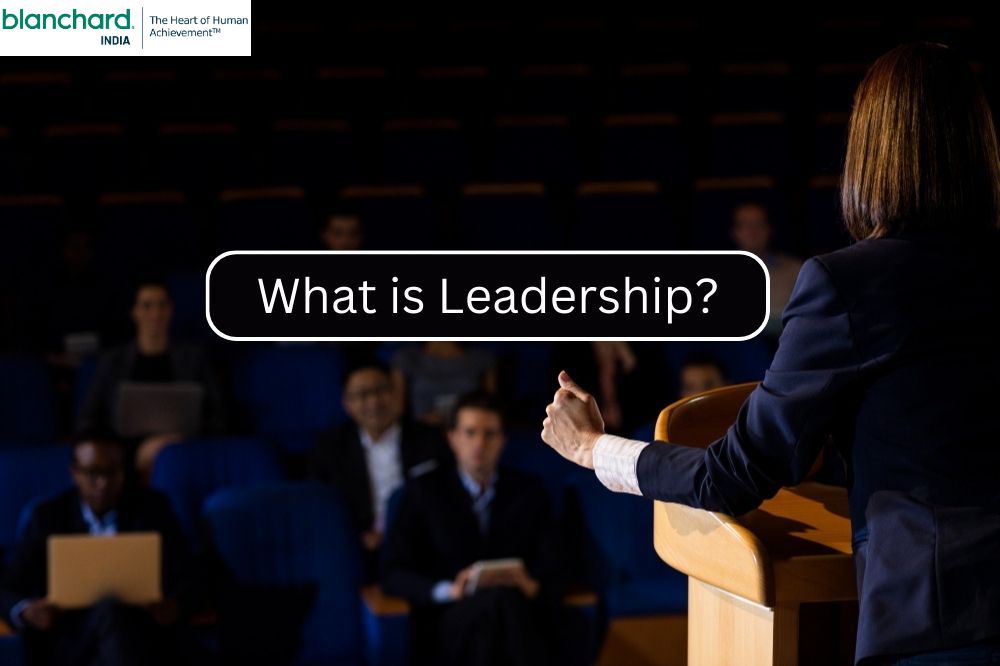Article Content
• Definition
• Understanding Leadership: A Comprehensive Perspective
• The Evolution of What is Leadership: A Transformative Journey
• 5 Significance of What is Leadership: A Guiding Force for Success
• Exploring 10 Leadership Theories: Unraveling the Dynamics
• 15 Key Attributes of What is Leadership: Unveiling the Essence
• Limits of Traditional Management Styles
• Cultivating Leadership Excellence: A Journey of Continuous Improvement
• Pioneering a Holistic Leadership Paradigm: The Essence of Servant Leadership
• FAQs Related to Leadership
Definition
What is Leadership? Leadership is like the glue that holds organizations and societies together, propelling progress. Simply put, it’s about the ability of people or groups to inspire and guide others, going beyond titles and ranks. While we often connect it to formal authority, leadership is something anyone can develop—a skill that grows with time and attention.
Understanding Leadership: A Comprehensive Perspective
1. Inclusive Nature of What is Leadership
- Leadership goes beyond titles and job positions—it includes various roles like executives, managers, coaches, and educators.
- It revolves around guiding and influencing outcomes and fostering collaboration among groups to achieve collective goals that may be challenging to attain individually.
2. Active Practice, Not an Inherent Trait
- It is a dynamic and learnable skill, challenging the misconception that it’s an innate quality.
- Rooted in adaptable mindsets, leadership expresses itself through observable behaviors, allowing individuals to cultivate and refine their leadership abilities over time actively.
3. Authenticity and Self-Awareness
- Effective leadership is grounded in authenticity and self-awareness.
- Shifting behaviors requires a conscious examination of thoughts and beliefs, emphasizing the importance of presenting oneself with integrity.
4. Contextual Relevance
- Context plays a pivotal role in understanding what leadership is, recognizing that strategies effective in one situation may not be universally applicable.
- A situational approach empowers leaders to tailor their strategies based on the specific context and evolution of their organizations.
5. McKinsey’s Insights on What is Leadership
- McKinsey’s analysis identifies four primary behaviors—being supportive, results-oriented, seeking different perspectives, and solving problems effectively.
- These behaviors collectively contribute to an impressive 89 percent of leadership effectiveness, emphasizing the significance of actionable and impactful implications of what leadership is.
6. Strategic Skill Development for Senior Leaders
- Senior leaders navigating organizational complexities must cultivate a versatile skill set.
- McKinsey’s “Leading Organizations: Ten Timeless Truths” outlines enduring principles, addressing critical topics such as talent attraction, retention, and the strategic advantage of fostering a positive organizational culture.
7. Dynamic Nature of What Is Leadership
- “Being a leader is a constant process of developing and adjusting oneself.”
- Emphasizing adaptability and continual learning, leaders play a pivotal role in guiding organizations toward sustained success in an ever-evolving landscape.
8. Communication Proficiency
- Effective leaders excel in communication, ensuring clarity in vision and goals.
- Proficient communication fosters engagement, collaboration, and a shared understanding among team members.
The Evolution of What is Leadership: A Transformative Journey
Understanding leadership has changed a lot over time. In the past, leadership was often seen as the same thing as “management.” It mainly focused on having technical skills and giving directions. This way of leading was strongly connected to traditional organizations in the industrial era, where the main goal was to maximize profits for shareholders.
In those organizations, leaders usually had one of three roles: planners, who created strategies and turned them into steps to follow; directors, who assigned roles and tasks to people; or controllers, who made sure everyone stuck to the plans. This setup showed the typical top-down and commanding leadership style of that industrial time.
But as organizations have changed, so has the idea of leadership. Nowadays, leadership is more than just management. It’s about being inclusive and adaptable and encouraging collaboration and innovation. This shift moves away from the strict ways of the past, highlighting a more flexible and diverse role for leaders in today’s complex and connected business world.
5 Significance of What is Leadership: A Guiding Force for Success
1. Strategic Direction and Communication
- Leadership Training Program is pivotal in providing a clear mission, vision, and goals for a business.
- Successful leaders excel in communicating these objectives, uniting team members, and steering them toward collective achievement.
2. Crucial Role in Times of Crisis
- Leadership becomes especially crucial during times of crisis.
- Effective leaders navigate challenges with resilience, providing stability and guidance to the organization.
3. Decision-Making and Problem Solving
- Leadership involves making hard decisions for the success and evolution of a business.
- Leaders with high competencies and emotional intelligence are relied upon to solve complex problems and guide the organization through uncertainties.
4. Trust and Positive Work Environments
- Trust is a cornerstone of successful leadership.
- Trustworthy leaders foster positive and productive work environments that encourage teamwork, employee well-being, and the development of strong work cultures.
5. Attraction of Top Talent
- Successful leadership often leads to organizational success and a positive reputation.
- Positive work cultures attract top talent, enhancing the organization’s competitiveness in the talent market.
Exploring 10 Leadership Theories: Unraveling the Dynamics
1. Great Man Theory (19th Century)
- Views leadership as an innate, exclusive skill possessed by select individuals.
- Suggests that exceptional leaders are born with inherent traits and qualities rather than developed through experience or learning.
2. Trait Theory (Mid-20th Century)
- It focuses on identifying specific personality traits linked to effective leadership.
- Highlights traits like integrity, self-confidence, decisiveness, and intelligence as crucial indicators of successful leaders.
3. Situational Leadership
- Adjusts leadership style based on the readiness or skill level of followers in specific situations.
- Acknowledges that different circumstances may require varying leadership approaches to achieve optimal results.
4. Contingency Theory
- Asserts that effective leadership depends on matching the right leader with the appropriate situation.
- It is important to note that leadership styles can be more effective in specific contexts.
5. Transactional Leadership
- Focuses on exchanges between leaders and followers to achieve desired outcomes.
- It involves rewarding or disciplining followers based on their performance and adhering to structured exchanges to motivate and guide behavior.
6. Transformational Leadership
- Inspires and motivates followers by appealing to their values, emotions, and higher aspirations.
- Encourages a shift in the mindset and behavior of followers, leading to transformative changes in their approach to work or life.
7. Behaviorist Theory
- Views leadership skills as products of environmental factors learned through experiences and exposure.
- Emphasizes that environmental influences significantly shape and contribute to an individual’s leadership capabilities.
8. Behavioral Theory
- Focuses on observable behaviors of effective leaders.
- Leaders model certain behaviors and actions, providing a positive example for others to emulate within the organizational context.
9. Functional Theory
- Centers on group dynamics and collective behaviors rather than individual traits.
- Highlights how the collective actions, interactions, and roles within a group contribute to effective leadership.
10. Path-Goal Theory
- Leaders set clear goals and facilitate pathways for followers to attain them, offering guidance and employee motivation training.
- Identifies different leadership styles aligned with specific goals, aiming to motivate and improve follower performance.
15 Key Attributes of What is Leadership: Unveiling the Essence
1. Strong, Realistic Visions
- “Effective leaders have a distinct and compelling perception of the future.”
- Their vision is not only inspirational but also grounded in realism, guiding the organization towards achievable goals.
2. Clear and Effective Communication
- Effective leaders communicate with clarity, ensuring their messages resonate with the team.
- Transparency and openness foster trust, enhancing overall communication effectiveness.
3. Adaptability, Flexibility, and Creativity
- Great leaders navigate dynamic landscapes with adaptability and flexibility.
- They embrace creativity, encouraging innovative thinking to address challenges and seize opportunities.
4. Honesty
- Integrity and honesty form the bedrock of ‘what is leadership’.
- Transparent and truthful communication establishes a foundation of trust within the team and organization.
5. Patience
- Patience is a virtue in leadership, especially when faced with complex challenges.
- Great leaders maintain composure, understanding that certain goals require time and persistence.
6. Resiliency
- Resilient leaders bounce back from setbacks, demonstrating perseverance.
- “They perceive challenges as chances to develop and acquire new knowledge.”
7. Emotional Intelligence and Empathy
- Great leaders understand and manage emotions effectively.
- Empathy fosters strong interpersonal relationships and a supportive organizational culture.
8. Integrity
- Unwavering integrity is a hallmark of great leadership.
- Consistency in actions aligns with ethical principles, reinforcing the leader’s credibility.
9. Collaboration
- Successful leaders foster collaboration within teams and across departments.
- They recognize the value of collective efforts in achieving shared goals.
10. Passion
- Great leaders exude passion for their work and the organization’s mission.
- Their enthusiasm is contagious, inspiring others to share in the commitment.
11. Fairness
- Fair and just decision-making is integral to great leadership.
- Leaders ensure equity, creating an inclusive environment that values diverse perspectives.
12. Cultural Awareness
- Leaders embrace cultural awareness, recognizing and respecting diversity.
- Cultural sensitivity strengthens relationships and promotes an inclusive workplace.
13. Intelligence and Expertise
- Intellectual prowess and expertise in the field are essential attributes.
- Continuous learning and staying abreast of industry trends contribute to effective leadership.
14. Strategic and Visionary Decision-Making
- Great leaders make strategic decisions aligned with the organization’s vision.
- Their visionary approach shapes a path for sustained success.
15. Persuade, Motivate, Empower, and Inspire
- Persuasive communication, motivation, empowerment, and inspiration are leadership tools that are synonymous with leadership training benefits.
- Great leaders evoke commitment, encouraging others to contribute to organizational goals willingly.
Limits of Traditional Management Styles
In the evolution of organizational dynamics, traditional management styles, once groundbreaking and instrumental in constructing globally impactful enterprises over the past two centuries, are encountering limitations in the 21st Century. The conventional approach, while effective in its time, fails to ensure the contentment or loyalty of managers and workers. An alarming 56 percent of American workers report having a boss with mild to high toxicity. In comparison, a staggering 75 percent find dealing with their manager the most stressful aspect of their workday.
As we navigate the complexities of today’s business landscape, a transformative shift is underway, demanding a novel approach to leadership. In the contemporary era, leaders are steering away from the traditional model, recognizing the need for agility, human-centric principles, and digital enablement. This progressive ‘what is leadership’ paradigm aims to create organizations capable of thriving amidst unprecedented challenges, catering to the diverse needs of stakeholders—ranging from customers and employees to suppliers and communities, in addition to investors. In adapting to this evolving framework, organizations aspire to foster a more inclusive, adaptive, and resilient environment tailored to the demands of the modern era.
Navigating the Spectrum of Leadership Styles: Understanding ‘What is Leadership’
In the realm of what is leadership, a diverse array of styles shapes the dynamics within businesses and organizations:
- Affiliative Leadership: Foster’s harmonious group dynamics, emphasizing positive relationships.
- Authoritative Leadership: Provides clear direction, expecting compliance while steering the team towards goals.
- Autocratic Leadership: Maintains absolute control and decision-making authority within the leadership.
- Charismatic Leadership: Leverages sociable and charming traits to persuade and inspire followers.
- Coaching Leadership: Educates and motivates individuals, guiding them towards the attainment of goals.
- Coercive Leadership: Enforces compliance with instructions, regardless of individual preferences.
- Command and Control (Bureaucratic) Leadership: Establishes stringent rules and regulations to govern organizational processes.
- Democratic Leadership: Prioritizes compromise and group consensus, involving others in decision-making.
- Leadership Innovation: Nurtures creativity and adaptability within the organizational framework.
- Laissez-faire Leadership: Adopts a hands-off approach, allowing individuals the freedom to operate independently.
- Pacesetter Leadership: Drives employees to achieve goals at an accelerated pace through emotional leadership styles.
- Transactional leadership operates by using a system of rewards and punishments to manage team dynamics.
- Servant Leadership: Focuses on serving the collective needs of the group and advancing the greater good.
- Situational Leadership: Adapts leadership styles to varying situations and individual needs.
Cultivating Leadership Excellence: A Journey of Continuous Improvement
In the dynamic landscape of the modern workplace, marked by the surge in remote work and a heightened focus on inclusive touch points such as diversity, equity, and inclusion, the path to becoming a better leader involves honing several key qualities:
Enhance Self-Awareness
Exceptional leaders cultivate self-awareness, understanding their strengths, weaknesses, and impact on their teams.
Polish Communication Skills
Effective leadership demands clear and compelling communication coupled with attentive listening.
Leaders foster openness, honesty, and transparency in communication, establishing clear goals, setting expectations, and providing regular, constructive feedback to their team members.
Forge Genuine Connections
Building meaningful connections with team members is pivotal, and fostering trust, understanding, and bonds is essential for successful leadership.
Astute leaders invest time in understanding the unique personalities and capabilities of their team, strengthening the fabric of collaboration.
Promote Growth Mindset
Exemplary leaders champion personal and professional growth, not only for themselves but also for their colleagues and team members.
Nurturing an environment that encourages continuous growth builds trust and amplifies the collective capabilities of the team.
Embrace Change
Effective leaders recognize the inevitability of change in the business landscape and embrace it.
Encouraging fresh ideas and diverse perspectives from team members, leaders propel adaptability and enhance their effectiveness.
Pursue Growth Opportunities
A commitment to continuous improvement is the hallmark and answer to what leadership is.
Actively seeking growth opportunities, such as attending conferences, finding mentors, and reading leadership literature, fuels the leader’s journey toward excellence.
Pioneering a Holistic Leadership Paradigm: The Essence of Servant Leadership
In the ever-evolving landscape of what is leadership, a transformative approach is emerging, often coined as “servant leadership.” While the terminology has faced scrutiny, the core concept is elegantly straightforward—leaders, instead of dictating and controlling, should serve those they lead. The emphasis lies on how leaders can enrich the lives of their team members physically, cognitively, and emotionally. Studies indicate that this mindset not only elevates team performance but also enhances overall satisfaction.
In this modern way of thinking, leaders show leadership by being understanding, kind, open, thankful, aware of themselves, and taking care of themselves. They create a culture where people feel valued and safe to share ideas and talk openly. This means acknowledging small successes, building connections between people, and caring about everyone’s well-being. All of this helps create a great environment for teams to do their best.
Expanding beyond conventional methodologies, this new leadership approach encapsulates five pivotal shifts that transcend traditional roles:
- Beyond Executive to Visionary: Shaping a compelling purpose resonant with holistic impact for all stakeholders.
- Beyond Planner to Architect: Reimagining industries and innovating business systems to create unprecedented value.
- Beyond Director to Catalyst: Engaging individuals in collaborative, empowered networks to foster open collaboration.
- Beyond Controller to Coach: Facilitating organizational evolution through continuous learning and empowering colleagues to develop new mindsets, knowledge, and skills.
- Beyond Boss to Human: Presenting one’s authentic self to the organizational sphere, emphasizing the importance of genuine connections, fosters a workplace culture that values individuals for who they are rather than just their roles and responsibilities.
To sum up, leadership isn’t a fixed endpoint but a journey that keeps changing. By understanding the twists and turns in figuring out what leadership means, people can develop a higher awareness. This helps guide organizations to succeed in the ever-changing modern world. Seeing leadership this way acts like a compass, steering towards excellence, teamwork, and positive influence.








